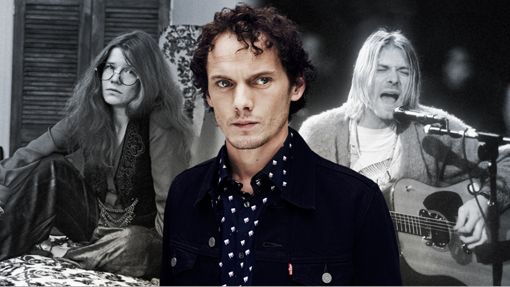The 27 Club: A Brief History, The Numbers Are Growing
The 27 Club has become one of the most elusive and remarkably tragic coincidences in rock & roll history. The term became widely known after Kurt Cobain’s death in 1994, with rock fans connecting his age to that of Jim Morrison, Janis Joplin, Brian Jones and Jimi Hendrix – though it was notable to fans in the early 1970s when those four visionaries died within just two years of each other. When Amy Winehouse passed away at age 27 in 2011, it attracted even more attention to the significance of the age. While the club has been largely connected to musicians, it has expanded since, as many young actors and artists have lost their lives due to everything from addiction to suicide to freak accidents. Here are some of the unfortunate and untimely losses connected to the club.
Robert Johnson

One of the Delta blues’ most celebrated and singular talents, Robert Johnson recorded chilling, folkloric songs about hellhounds, the Devil and general despair amid swinging, dissonant, sometimes off-kilter guitar lines – the likes of which have reverberated through rock & roll for decades. He recorded less than 50 songs – including ones later covered by Cream (“Cross Road Blues”), Captain Beefheart (“Terraplane Blues”) and the Rolling Stones (“Love in Vain,” “Stop Breaking Down”) – and performed alongside the likes of Howlin’ Wolf, Elmore James and Memphis Slim as he rose to fame. “You want to know how good the blues can get?” Keith Richards once said. “Well, this is it.” In August 1938, just a few months after his 27th birthday, Johnson made moves on the wife of the owner of a roadhouse where he was playing, drank from an open bottle of whiskey he was offered, and died three days later of strychnine poisoning and pneumonia. He is buried in an unmarked grave in Mississippi.
Brian Jones

Jones’ death at his country home in England in 1969 seems to be the result of his foolish behavior. To mix alcohol and drugs and then dive into the swimming pool was to swim directly into the arms of death. As clear as this seems, the death of Brian Jones has become one of the most persistent mysteries of rock & roll, with many people questioning the official version of what happened. Even members of the Rolling Stones have expressed doubts. “And still the mystery of his death hasn’t been solved,” Keith Richards has said. “I don’t know what happened, but there was some nasty business going on.”
Alan Wilson

Canned Heat enjoyed considerable artistic and commercial success, crowned by an appearance at Woodstock in 1969. But guitarist Al “Blind Owl” Wilson was a troubled man. Like many in the 27 Club, he was estranged from his family; he lacked confidence and suffered from depression. One of his eccentric habits was sleeping outdoors, as he did at vocalist Bob Hite’s house in Los Angeles on the last night of his life. Wilson’s body was found in Hite’s yard on September 3rd, 1970. His hands were crossed over his chest and there was a bottle of the barbiturate Seconal by his side. Cause of death was officially given as an accidental overdose of barbiturates, but drummer Fito de la Parra has said he believes Wilson committed suicide.
Jimi Hendrix

In the early hours of Friday, September 18th, 1970, while staying with a girlfriend in London, Jimi took some sleeping pills. Nobody knows for sure how many pills he swallowed, or whether he understood what he was taking. The drug was Vesparax, a strong barbiturate. Half a tablet was enough to put a man to sleep for eight hours – Jimi may have swallowed as many as nine. He had also been drinking. This was foolish and reckless but it was in character. During his years on the road Jimi had got into the habit of using drugs indiscriminately. “Jimi would take a handful of shit, not even knowing what it was,” his friend Deering Howe has said.
Janis Joplin

It is certainly easy to imagine Janis feeling lonely as she returned to her hotel room in Hollywood after her last recording session. As she sang in “A Woman Left Lonely,” one of the last songs she sang, she knew that her boyfriend was taking her for granted. At around one a.m. on October 4th, 1970, she got her heroin kit out and injected a vein in her left arm. Then she went to the cigarette machine in the hotel lobby, returning to her room with a pack. She closed the door, started to undress and reached to put her packet on the nightstand. As she did so she keeled over, hitting her face on the table as she fell to the floor, where she was found dead the next day.
Jim Morrison

The cult of Jim Morrison grew posthumously, taking off in 1979 when Francis Ford Coppola used “The End” in the soundtrack for Apocalypse Now. Part of the cult of Jim was the coincidence of him dying at the same age as Brian, Jimi and Janis. The 27 link helped reinforce the idea that Jim had been special; that his death was fated; that there was somethingweird going on. The fact that Jim’s girlfriend had died at the same age underlined the weirdness of the coincidence. This legend was familiar to everybody with an interest in popular music by 1994 when Kurt Cobain decided to join the club.
Ronald McKernan

Ron “Pigpen” McKernan was a sensitive, somewhat unsightly character with a drinking problem. He got together with Jerry Garcia and Bob Weir in 1964 to form a jug band thatdeveloped into the Grateful Dead. Pigpen started drinking when he was twelve and, by his mid-twenties, had cirrhosis of the liver, ulcers and other health problems. Pigpen was on his own at his apartment in Corte Madera, overlooking San Francisco Bay, when the end came on March 8th, 1973. He had been dead for up to two days when his landlady found him.
Pete Ham

After Kurt Cobain, the most notable confirmed suicide is Peter Ham of Badfinger, one of the bands the Beatles signed to their Apple label in the 1960s. As is the case with suicides, Ham reached a point where death seemed to be the only solution to his problems. He met bandmate Tom Evans in a pub near his home in England on the evening of April 24th, 1975, three days before his 28th birthday, and told him: “Don’t worry, I know a way out.” Fortified with drink, Ham went back to his home, wrote a note in which he expressed his bitterness towards his manager and hanged himself in his garage. Evans hanged himself seven years later.
Kurt Cobain

Kurt Cobain’s body was discovered by an electrician on Friday, April 8th, 1994. The answer to the question posed by the authors of Who Killed Kurt Cobain? is simple: Kurt Cobain killed himself. He did so with sudden, self-inflicted violence, leaving written evidence of his state of mind. Kurt’s substance abuse counselor remembered how worried the musician had been about losing his home in a lawsuit: “Suicidal people tend to want to make a statement,” Nial Stimson said. “I just kind of felt he killed himself in his house [as if to say], “You’re not going to take my house, no matter what. . .'”
Jean-Michel Basquiat

The year Jean-Michel Basquiat turned 20, he became an art-world celebrity on the path to a pop-culture turning point. After dropping out of high school, the self-taught, Brooklyn-born, neo-expressionist artist spent the late Seventies painting graffiti around SoHo, tagged “SAMO,” and in 1980, he allowed his paintings – which featured colorful, jagged renditions of people often juxtaposed with words – to be featured in a group show. In the years that followed, he collaborated with Andy Warhol on a series of paintings, dated Madonna, appeared in Blondie’s “Rapture” video and cultivated the myth of the temperamental artist, destroying some paintings and pouring dried fruit and nuts on the head of an art dealer. Along the way, he developed a serious drug problem. In the months leading up to his death in 1988 of “acute mixed drug intoxication” – namely opioids and cocaine – he claimed to be shooting a hundred bags of heroin a day. He’s since become one of the most celebrated artists of the past three decades, having been the subject of a biopic and uncountable references in Jay Z songs.
Kristen Pfaff

One of the mourners at Kurt’s Seattle memorial was Kristen Pfaff, a member of Courtney Love’s band, Hole, and a former girlfriend of fellow member Eric Erlandson. Two months after Kurt’s death, in 1994, Pfaff died of a heroin overdose in the bath at her Seattle apartment, just like Jim Morrison. She was also 27, the third member of the Seattle music community to die at that age within a year.
Jonathan Brandis

Jonathan Brandis’ 2003 suicide is a dark reflection of the too-frequent downfall of former child stars. Brandis began acting at age six, holding down bit parts in soap operas and sitcoms before graduating to films like Stephen King’s It. But it wasn’t until 1993, at the age of 17, when he got his big break in the popular series SeaQuest DSV. He became an instant heartthrob, receiving thousands of fan letters and causing levels of public pandemonium that neared Beatlemania. But the show was cancelled in 1996, and Brandis struggled to maintain his fame and career. In 2002, he was set to appear in Hart’s War starring Bruce Willis and Colin Farrell – a film he saw as his opportunity for a comeback – but all of his scenes were cut. A year later, he hanged himself in his Los Angeles apartment and later died at Cedars-Sinai Hospital.
Amy Winehouse

What Amy’s state of mind was when she took her last gulps of vodka at home in London in July 2011 is impossible to know. She had said there were things she still wanted to do with her life, but she seemed unable to take action. Despite being a remarkably honest and open person in many respects, she had always been cagey about her inner life. Observing Amy as we have, there is a strong sense that she was sick of her career. Like Jimi Hendrix and Kurt Cobain, she had become a prisoner of her image. And, as with Janis Joplin, her man was glaringly absent at the end. So were other people Amy had depended upon and, in many cases, exhausted.
Anton Yelchin

Anton Yelchin did a lot of work in his 27 years – from 2011 to 2015 alone, he appeared in 18 films, not including various voiceover gigs – and yet not nearly enough. A sensitive actor with a penchant for visionary auteurs such as Jim Jarmusch, Drake Doremus, and Jeremy Saulnier, his best years had barely begun when he died in a freak accident, pinned against a brick pillar by his own car. But he leaves behind a versatile, stellar filmography jumping from blockbusters (he made for an excitable Chekov in the Star Trek reboots) to horror homage (he was the spine of 2011’s Fright Night remake) to small-scale romance (he courted Felicity Jones in Like Crazy). There’s no telling what he could’ve done, but now, all we can do is be grateful for what we’ve got.
Entries 2-8, 10, 11 and 13 adapted from 27: A History of the 27 Club through the Lives of Brian Jones, Jimi Hendrix, Janis Joplin, Jim Morrison, Kurt Cobain, and Amy Winehouse by Howard Sounes.
Rolling Stone




